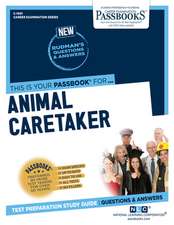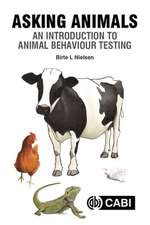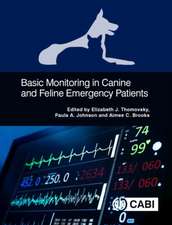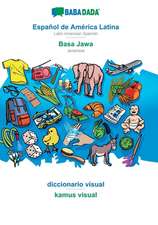The Ultimate Guide for Horses in Need
Autor Stacie G Boswellen Limba Engleză Paperback – 16 iun 2020
- Where they come from: The origins of the unwanted, neglected, or abused horse.
- Hoof care, lameness, and wounds: Evaluating hoof structure and the horse's movement, trimming and shoeing, abscesses, laminitis, arthritis, and bandaging.
- Birth control: Castration and mare management.
- Foal rescue: The birthing process, working with orphans, halter training, and hoof handling.
- The "down" horse: Identifying and treating underlying problems, rolling a horse, bed sores, slings, and quality of life considerations.
- Working in disaster scenarios: Preparedness, identification, transportation, communication, and first aid.
- Euthanasia: Compassionate guidelines, procedures, and aftercare.
- Unique training considerations: Coming into work according to BCS.
- How horses sense and respond: Equine vision, training principles, and working with the fearful horse.
- Developing a relationship with your rescue: Social integration, developing trust, overcoming fear, handling feet and legs, halter training adult horses, preparing a horse for medical care, groundwork, and riding.
In the United States alone, it is estimated that almost 150,000 horses per year are "unwanted." This number grows exponentially when you consider horses worldwide. Horses that are old, injured, sick, unmanageable, or fail to meet expectations deserve to be treated with dignity and given every chance for a comfortable life in the company of humans. Dr. Boswell's book helps make this possible.
Preț: 204.51 lei
Preț vechi: 215.27 lei
-5% Nou
Puncte Express: 307
Preț estimativ în valută:
39.15€ • 40.70$ • 32.46£
39.15€ • 40.70$ • 32.46£
Carte disponibilă
Livrare economică 16-30 ianuarie 25
Preluare comenzi: 021 569.72.76
Specificații
ISBN-13: 9781570769627
ISBN-10: 1570769621
Pagini: 264
Ilustrații: 223 Halftones, color
Dimensiuni: 208 x 259 x 18 mm
Greutate: 0.89 kg
Editura: Trafalgar Square Books
ISBN-10: 1570769621
Pagini: 264
Ilustrații: 223 Halftones, color
Dimensiuni: 208 x 259 x 18 mm
Greutate: 0.89 kg
Editura: Trafalgar Square Books
Notă biografică
Stacie Boswell, DVM, DACVS, is an equine veterinarian who completed five years of specialty training beyond veterinary school, earning Diplomat status with the American College of Veterinary Surgeons (ACVS). Through this training, she has worked with horses in veterinary medicine in Virginia, North Carolina, New York, Tennessee, New Mexico, and Montana, completed a three-year surgical residency, and spent additional training time with pathology, radiology, anesthesia, and internal medicine specialists. She has raised and trained her own horses for over two decades, and is a lifetime member of the AQHA and APHA, as well as participating in Backcountry Horsemen of America (BCHA), volunteering to keep trails open to riders and maintained in her region.
Cuprins
Chapter One Where They Come From: Horses in Need
Introduction
[sidebar] The Five Freedoms
The Unwanted or Neglected Horse
[sidebar] A Cautionary Tale
Economic Factors
Horse Population Changes
[sidebar] Large North American Breed Registries
The Horse Industry Improves
Technology in Rescue
Confiscation or Assistance
[sidebar] Long-Term Consequences
How to Take Proper Care of Your Rescued Horse
Chapter Two Bringing Them Home: Traveling and Intake of Your Rescue Horse
Introduction
Get Ready to Roll
Trailer Inspection and Safety
[sidebar] Pre-Drive Checklist, Professional Trailer Inspection
Driver Safety
Loading Your Horse
Know Your Horses
[sidebar] Watch Your Step
Travel Stress of Horses
Preventing Respiratory Illness While Traveling
Travel Time
Reducing Stress - Rest Your Horses
Other Ways to Reduce Stress
Halter and Tie Horses Properly
Dress Horses Properly
Trailer Regulations for Mustangs
Trailer Regulations for Slaughter
Travel Summary
Identification
Permanent Identification
Natural Features
Brands
Lip Tattoos
[sidebar] Never Look a Gift Horse in the Mouth
Microchipping
Temporary Identification
Tags and Collars
Traceability
Ownership
Quarantine
Veterinary Examination
Laboratory Testing
Fecal Evaluation
Coggins Test
Bloodwork
Summary
Chapter Three Rest and Digest: Nutrition, Dentistry, and Colic
Nutrition
Body Condition Scoring
[chart] Original Henneke Body Condition Score Table
Starvation
Refeeding Syndrome
Safely Feeding the Starved Horse
Feeding Program
Days One Through Three
Day Four to Two Weeks
Two Weeks to Two Months
Long-Term
[sidebar] Skinny Surprise
Forages
Forage Selection
Forage Facts
[chart] Factors Affecting Non-Structural Carbohydrates (NSC)
Nutrient Content of Forage
Other Feeds
Grains
Feeding Fats
Use of Probiotics
Long-term Weight Changes
[chart] Example Rations
Monitor His Weight
Other Considerations for Re-Feeding Rescue Horses
Feeding Summary
Psychological Effects of Starvation
Extra Winter Care for the Emaciated Horse
Dentistry
Other Reasons for Weight Loss
Gastric Ulcers
Colic
Signs of Colic
[sidebar] List of Colic Signs
Types of Colic
Impaction Colic
Gas Colic
Preventing Colic
Hydration
Avoid Sudden Changes in Feed
Veterinary Evaluation and Treatment of Colic
Further Treatment & Management of Colic
[sidebar] Hobby Horse Rescuer
Summary
Chapter Four Germs and Worms: Vaccination and Parasite Management
Parasite Management and Deworming
Parasite Management
Toxicity and Environmental Concerns
Manure Management
Fecal Egg Count
[sidebar] Modified McMaster's Fecal Evaluation
Special Cases and Considerations
Deworming Needy Horses
Parasite Management Summary
Ectoparasites and Skin Conditions
Other Skin Conditions
Vaccines
Tetanus
Rabies
Mosquito-borne Viruses that Affect the Nervous System.
Eastern, Western, and Venezuelan Encephalitis
West Nile Virus
Respiratory Diseases
Herpes/Rhinopneumonitis
Influenza
Strangles
Respiratory Disease in Needy Equines
Diagnosing Respiratory Illness
Treating Respiratory Illness
Summary
[chart] Table of Vaccines
Chapter Five Keeping Them Moving and Sound: Hoof Care, Lameness, and Wounds
[sidebar] Pain and Attitude
Foot Anatomy
Routine Hoof Care
Factors Affecting Hoof Structure and Growth
How Nutrition Affects Hoof Growth
How Genetics Affect Hoof Growth
[sidebar] Long Ears
How Environment Affects Hooves
Recognizing Lameness in Rescue Horses
Evaluating the Feet of a Rescue Horse
Hoof Neglect
Mismatched Hooves
Club Foot
Laminitis
Monitoring Movement
[sidebar] Bobbing Bobby
When to Shoe
If Wear Exceeds Growth, Shoes are Necessary
If the Horse Experiences Foot Pain, Shoes are Necessary
Shoeing Horses with Abnormalities
Causes of Lameness
Injuries That Damage the Hoof
Hoof Abscesses
Laminitis
Chronic Generalized Arthritis
Non-Steroidal Anti-Inflammatory Drugs
Disease Modifying Osteoarthritis Drugs
Steroid Injections
[chart] Arthritis Treatment Table
Wounds
Wound Evaluation
Wound Treatment
Bandaging
Extensive or Deep Wounds
Infected Wounds
Summary
Chapter Six Birth Control: Managing Mares and Castrating Colts
Castration of Males
When to Safely Castrate Males
Before Castration
Anesthesia
Routine Castration
Routine After-Care
Long-term Expectations
Castration Complications
Swelling
What to do About Swelling
Hemorrhage
What to do About Bleeding
Infection
What to do About Infection
Other Complications
[sidebar] Long Ears: Castration of Other Equines
Cryptorchid Castration
Why Cryptorchidism Happens
Why Cryptorchids Often Need Help
The Proud-Cut Myth
[sidebar] The Proud-Cut Lottery
Paraphimosis
Pregnancy Evaluation in Mares and Fillies
[chart] Cost of Pregnancy Diagnosis
[sidebar] Two for One
Pregnant Mare Nutrition
Caloric Needs Increase
Fescue
Vaccines for Pregnant Mares
Equine Herpesvirus
Other Vaccines
Spaying Mares
Summary
Chapter Seven Little Lives: Rescuing Foals
The Birthing Process
[start sidebar] Long Ears
Predicting Foaling Time
[sidebar] Tragic Accident
Timing: Foaling Happens Quickly
Foal Positioning Problems
Red Bag
Normal After-Birth Sequence
Suckling
Passage of Meconium
Foal Examination
[sidebar] Normal Vital Parameters for Foals
[within sidebar] Temperature, Heart, Respiration
Examination of the Limbs
Contracted Tendons
Tendon Laxity
Joint Infection
Growth Abnormalities
Special Examination
Evaluation of Passive Transfer of Immunity
Umbilicus
Ribs
Palate
[sidebar] Other Abnormalities that Warrant Veterinary Care
[sidebar] Long Ears
Normal Foal Behavior
The Orphan Foal
Feeding Orphan Foals
Alternatives to Colostrum - Birth to 24 Hours
Nutrition From Two Days to Two Weeks.
[sidebar] Nurse Mare Non-Match
Frequency of Feeding
Feeding Containers & Methods
Volume Your Foal Will Eat
Feeding - Two Weeks to Two Months
[chart] Timeline for Foals
Orphan Socialization
[sidebar] Too Close for Comfort
Nurse-Mare Farms
Halter Training
When to Begin
Putting on the Halter
Learning to Lead
Following the Mare
Butt Rope
Pressure and Release
Picking up Feet
Other Training
Summary
Chapter Eight Unable to Rise: The Down Horse
The Down Horse
Safety
Normal Sleeping Patterns
Reasons For a Horse to be Down
[sidebar] Reasons Why a Horse is Down
Pain
Neurologic disease
Environment
Metabolic Illness
Identifying Underlying Problems
Treating Underlying Problems
How to Get The Down Horse Up
Identify and Remove Obstacles
Rolling a Horse
Sliding to Reposition
Get Him Up (Prepare and Assist)
Long-Term Treatment of Underlying Problems
Long-Term Down Horse
Bed Sores and Skin Injuries
Use of Slings
Summary
Chapter Nine Urgent Rescue: Working in Disasters
Disaster Preparedness
Learn About Your Locale
Plan Ahead
Prepare your Plan
Location
Prepare for Transport
Identify Your Horse
[sidebar] Make Your Go Bucket
[sidebar] Sarah's Story
Guidelines for Working in Natural Disasters and Accidents
Communication
Technical Large Animal Emergency Rescue
[sidebar] Potential Response Team Members
First Aid for Horses
[sidebar] Normal Vital Parameters for Horses
Leg Wounds
Eyes
Wounds on the Body
Specific Disasters and their Equine Health Consequences
Fire
Floods
Falling through ice or into a swimming pool
High Winds
Heat Waves
Blizzards and Snow
Summary
Chapter Ten A Good Goodbye: Euthanasia
Making the Decision
Compassionate Guidelines
Other Reasons for Euthanasia
Euthanasia Procedure
Most Common Procedure
[sidebar] Saying Goodbye to Buddy
Confirming Death
After Care
Cost
Take Home Message
Part Two - Training
[Section Intro]
[sidebar] Training Appropriate by BCS
Chapter Eleven How Horses Sense and Respond: Sensory Physiology, Training Concepts, and Thought Processes (Fear)
Sensory Physiology
Equine Vision
Field of View
Color Perception
Light Perception
[sidebar] Blind Trust
Other Senses
Hearing
[sidebar] White-associated Deafness
Sense of Smell
Understanding his Senses
Training Principles
Positive Reinforcement
[sidebar] Clicker & Positive Reinforcement Training
Intrinsic Reward and Bribery
Negative Reinforcement
Approach and Retreat
[sidebar] Click-it or Ticket
Punishment
Abuse
The Fearful Horse & Rescue Training
The Fear Response
Recognizing Fear - What Your Horse is Telling You
[sidebar] Signs of Apprehension or Fear
[sidebar] Long Ears
Physiology of Fear
[sidebar] A Violation of Trust
Recognizing Relaxation - What Your Horse is Telling You
[sidebar] Signs of Relaxation and Comfort
Changing Fear
Helping Others Improve Their Training Skills
Summary
Chapter Twelve Restoring Trust: Developing a Relationship
[Sidebar] Chapter Twelve Checklist.
Social Integration
Develop a Foundation of Trust
Routine and Respect
Behavior and Weakness
Rebuild Muscle
Consistency and Fairness
Training Stress
Novelty and Anxiety
Fear of Whips
Scary Objects
[start sidebar] Some Stuff Your Steed May Be Afraid Of
Overcoming Fear
Medically Addressing Fear
[start sidebar] The Twitch
Mealtime Anxiety
[sidebar] The Portly Paso
Handling Feet and Legs with Trust
Picking up The Feet of a Trained Adult
Normal Nerves
Proper Pick-up
[start sidebar] Shivers
Training for Hoof Care
Get Assistance
Touch First
Shift Weight
Lift a Front Foot
Training for Hind Legs
Keep it Up
Preparing for the Farrier
Setting his Foot Down
Go Slow to Obtain Consistent Results
Using a Rope
Summary
Chapter Thirteen Fearless: Halter Training Adult Horses
[Sidebar] Chapter Thirteen Checklist
Horse Personality
The Flight Zone
Enclosure Guidelines
Reduce Flight Zone
Round Pen
Initiate Touch
Haltering and Halter Types
Flat Halters
Rope Halters
Halter Fit
Applying the Halter
Halter Training
Tying
The Sick Horse
Conclusion
Chapter Fourteen Patient Training: Skills for Medical Care
[Sidebar] Chapter Fourteen Checklist
Reviewing Approach-and-Retreat
Advanced Leading Skills - Tight Spaces and New Situations
Thinking About His Options
[sidebar] Rushed - A Leading Story
Advanced Leading Skills
Small Spaces
Trailers
Training Horses that Don't Know How to Load
Eliminate the Fear Factor
Teach Him Unloading First
Drive On
Entering the Hospital Environment
Entering and Being Restrained in Stocks
Physical Examination
Physical Touch
Evaluating Gums
Rectal Temperature
Nervous Nellies
Companionship for Reassurance
Oral Medications
Injection Training
Retraining Needle-Shy Horses
Desensitize Your Horse to Injections - Long-Term Training
Preparation for Intranasal Treatments
Summary
Chapter Fifteen Getting Going: Groundwork
[Sidebar] Chapter Fifteen Checklist
Safety First
Health Status of the Horse
Considerations of the Mental Status of the Horse
Longeing
Longeing Movements
Halting When Longing
Increasing Speed
[sidebar] Not Trotting
[sidebar] Rowdy Ranger: A Need for Training
Tacking Up
Saddle Pad
Saddle
Notes About Bucking
Summary
Chapter Sixteen Final Steps: Riding
[Sidebar] Chapter Sixteen Checklist
Before Riding
Lameness Evaluation
[sidebar] Upward Fixation of the Patella
To Bridle or Not to Bridle
Bridle Fit
Mounting
Steps of Desensitization for Mounting
[sidebar] The Final Phase
Summary
Introduction
[sidebar] The Five Freedoms
The Unwanted or Neglected Horse
[sidebar] A Cautionary Tale
Economic Factors
Horse Population Changes
[sidebar] Large North American Breed Registries
The Horse Industry Improves
Technology in Rescue
Confiscation or Assistance
[sidebar] Long-Term Consequences
How to Take Proper Care of Your Rescued Horse
Chapter Two Bringing Them Home: Traveling and Intake of Your Rescue Horse
Introduction
Get Ready to Roll
Trailer Inspection and Safety
[sidebar] Pre-Drive Checklist, Professional Trailer Inspection
Driver Safety
Loading Your Horse
Know Your Horses
[sidebar] Watch Your Step
Travel Stress of Horses
Preventing Respiratory Illness While Traveling
Travel Time
Reducing Stress - Rest Your Horses
Other Ways to Reduce Stress
Halter and Tie Horses Properly
Dress Horses Properly
Trailer Regulations for Mustangs
Trailer Regulations for Slaughter
Travel Summary
Identification
Permanent Identification
Natural Features
Brands
Lip Tattoos
[sidebar] Never Look a Gift Horse in the Mouth
Microchipping
Temporary Identification
Tags and Collars
Traceability
Ownership
Quarantine
Veterinary Examination
Laboratory Testing
Fecal Evaluation
Coggins Test
Bloodwork
Summary
Chapter Three Rest and Digest: Nutrition, Dentistry, and Colic
Nutrition
Body Condition Scoring
[chart] Original Henneke Body Condition Score Table
Starvation
Refeeding Syndrome
Safely Feeding the Starved Horse
Feeding Program
Days One Through Three
Day Four to Two Weeks
Two Weeks to Two Months
Long-Term
[sidebar] Skinny Surprise
Forages
Forage Selection
Forage Facts
[chart] Factors Affecting Non-Structural Carbohydrates (NSC)
Nutrient Content of Forage
Other Feeds
Grains
Feeding Fats
Use of Probiotics
Long-term Weight Changes
[chart] Example Rations
Monitor His Weight
Other Considerations for Re-Feeding Rescue Horses
Feeding Summary
Psychological Effects of Starvation
Extra Winter Care for the Emaciated Horse
Dentistry
Other Reasons for Weight Loss
Gastric Ulcers
Colic
Signs of Colic
[sidebar] List of Colic Signs
Types of Colic
Impaction Colic
Gas Colic
Preventing Colic
Hydration
Avoid Sudden Changes in Feed
Veterinary Evaluation and Treatment of Colic
Further Treatment & Management of Colic
[sidebar] Hobby Horse Rescuer
Summary
Chapter Four Germs and Worms: Vaccination and Parasite Management
Parasite Management and Deworming
Parasite Management
Toxicity and Environmental Concerns
Manure Management
Fecal Egg Count
[sidebar] Modified McMaster's Fecal Evaluation
Special Cases and Considerations
Deworming Needy Horses
Parasite Management Summary
Ectoparasites and Skin Conditions
Other Skin Conditions
Vaccines
Tetanus
Rabies
Mosquito-borne Viruses that Affect the Nervous System.
Eastern, Western, and Venezuelan Encephalitis
West Nile Virus
Respiratory Diseases
Herpes/Rhinopneumonitis
Influenza
Strangles
Respiratory Disease in Needy Equines
Diagnosing Respiratory Illness
Treating Respiratory Illness
Summary
[chart] Table of Vaccines
Chapter Five Keeping Them Moving and Sound: Hoof Care, Lameness, and Wounds
[sidebar] Pain and Attitude
Foot Anatomy
Routine Hoof Care
Factors Affecting Hoof Structure and Growth
How Nutrition Affects Hoof Growth
How Genetics Affect Hoof Growth
[sidebar] Long Ears
How Environment Affects Hooves
Recognizing Lameness in Rescue Horses
Evaluating the Feet of a Rescue Horse
Hoof Neglect
Mismatched Hooves
Club Foot
Laminitis
Monitoring Movement
[sidebar] Bobbing Bobby
When to Shoe
If Wear Exceeds Growth, Shoes are Necessary
If the Horse Experiences Foot Pain, Shoes are Necessary
Shoeing Horses with Abnormalities
Causes of Lameness
Injuries That Damage the Hoof
Hoof Abscesses
Laminitis
Chronic Generalized Arthritis
Non-Steroidal Anti-Inflammatory Drugs
Disease Modifying Osteoarthritis Drugs
Steroid Injections
[chart] Arthritis Treatment Table
Wounds
Wound Evaluation
Wound Treatment
Bandaging
Extensive or Deep Wounds
Infected Wounds
Summary
Chapter Six Birth Control: Managing Mares and Castrating Colts
Castration of Males
When to Safely Castrate Males
Before Castration
Anesthesia
Routine Castration
Routine After-Care
Long-term Expectations
Castration Complications
Swelling
What to do About Swelling
Hemorrhage
What to do About Bleeding
Infection
What to do About Infection
Other Complications
[sidebar] Long Ears: Castration of Other Equines
Cryptorchid Castration
Why Cryptorchidism Happens
Why Cryptorchids Often Need Help
The Proud-Cut Myth
[sidebar] The Proud-Cut Lottery
Paraphimosis
Pregnancy Evaluation in Mares and Fillies
[chart] Cost of Pregnancy Diagnosis
[sidebar] Two for One
Pregnant Mare Nutrition
Caloric Needs Increase
Fescue
Vaccines for Pregnant Mares
Equine Herpesvirus
Other Vaccines
Spaying Mares
Summary
Chapter Seven Little Lives: Rescuing Foals
The Birthing Process
[start sidebar] Long Ears
Predicting Foaling Time
[sidebar] Tragic Accident
Timing: Foaling Happens Quickly
Foal Positioning Problems
Red Bag
Normal After-Birth Sequence
Suckling
Passage of Meconium
Foal Examination
[sidebar] Normal Vital Parameters for Foals
[within sidebar] Temperature, Heart, Respiration
Examination of the Limbs
Contracted Tendons
Tendon Laxity
Joint Infection
Growth Abnormalities
Special Examination
Evaluation of Passive Transfer of Immunity
Umbilicus
Ribs
Palate
[sidebar] Other Abnormalities that Warrant Veterinary Care
[sidebar] Long Ears
Normal Foal Behavior
The Orphan Foal
Feeding Orphan Foals
Alternatives to Colostrum - Birth to 24 Hours
Nutrition From Two Days to Two Weeks.
[sidebar] Nurse Mare Non-Match
Frequency of Feeding
Feeding Containers & Methods
Volume Your Foal Will Eat
Feeding - Two Weeks to Two Months
[chart] Timeline for Foals
Orphan Socialization
[sidebar] Too Close for Comfort
Nurse-Mare Farms
Halter Training
When to Begin
Putting on the Halter
Learning to Lead
Following the Mare
Butt Rope
Pressure and Release
Picking up Feet
Other Training
Summary
Chapter Eight Unable to Rise: The Down Horse
The Down Horse
Safety
Normal Sleeping Patterns
Reasons For a Horse to be Down
[sidebar] Reasons Why a Horse is Down
Pain
Neurologic disease
Environment
Metabolic Illness
Identifying Underlying Problems
Treating Underlying Problems
How to Get The Down Horse Up
Identify and Remove Obstacles
Rolling a Horse
Sliding to Reposition
Get Him Up (Prepare and Assist)
Long-Term Treatment of Underlying Problems
Long-Term Down Horse
Bed Sores and Skin Injuries
Use of Slings
Summary
Chapter Nine Urgent Rescue: Working in Disasters
Disaster Preparedness
Learn About Your Locale
Plan Ahead
Prepare your Plan
Location
Prepare for Transport
Identify Your Horse
[sidebar] Make Your Go Bucket
[sidebar] Sarah's Story
Guidelines for Working in Natural Disasters and Accidents
Communication
Technical Large Animal Emergency Rescue
[sidebar] Potential Response Team Members
First Aid for Horses
[sidebar] Normal Vital Parameters for Horses
Leg Wounds
Eyes
Wounds on the Body
Specific Disasters and their Equine Health Consequences
Fire
Floods
Falling through ice or into a swimming pool
High Winds
Heat Waves
Blizzards and Snow
Summary
Chapter Ten A Good Goodbye: Euthanasia
Making the Decision
Compassionate Guidelines
Other Reasons for Euthanasia
Euthanasia Procedure
Most Common Procedure
[sidebar] Saying Goodbye to Buddy
Confirming Death
After Care
Cost
Take Home Message
Part Two - Training
[Section Intro]
[sidebar] Training Appropriate by BCS
Chapter Eleven How Horses Sense and Respond: Sensory Physiology, Training Concepts, and Thought Processes (Fear)
Sensory Physiology
Equine Vision
Field of View
Color Perception
Light Perception
[sidebar] Blind Trust
Other Senses
Hearing
[sidebar] White-associated Deafness
Sense of Smell
Understanding his Senses
Training Principles
Positive Reinforcement
[sidebar] Clicker & Positive Reinforcement Training
Intrinsic Reward and Bribery
Negative Reinforcement
Approach and Retreat
[sidebar] Click-it or Ticket
Punishment
Abuse
The Fearful Horse & Rescue Training
The Fear Response
Recognizing Fear - What Your Horse is Telling You
[sidebar] Signs of Apprehension or Fear
[sidebar] Long Ears
Physiology of Fear
[sidebar] A Violation of Trust
Recognizing Relaxation - What Your Horse is Telling You
[sidebar] Signs of Relaxation and Comfort
Changing Fear
Helping Others Improve Their Training Skills
Summary
Chapter Twelve Restoring Trust: Developing a Relationship
[Sidebar] Chapter Twelve Checklist.
Social Integration
Develop a Foundation of Trust
Routine and Respect
Behavior and Weakness
Rebuild Muscle
Consistency and Fairness
Training Stress
Novelty and Anxiety
Fear of Whips
Scary Objects
[start sidebar] Some Stuff Your Steed May Be Afraid Of
Overcoming Fear
Medically Addressing Fear
[start sidebar] The Twitch
Mealtime Anxiety
[sidebar] The Portly Paso
Handling Feet and Legs with Trust
Picking up The Feet of a Trained Adult
Normal Nerves
Proper Pick-up
[start sidebar] Shivers
Training for Hoof Care
Get Assistance
Touch First
Shift Weight
Lift a Front Foot
Training for Hind Legs
Keep it Up
Preparing for the Farrier
Setting his Foot Down
Go Slow to Obtain Consistent Results
Using a Rope
Summary
Chapter Thirteen Fearless: Halter Training Adult Horses
[Sidebar] Chapter Thirteen Checklist
Horse Personality
The Flight Zone
Enclosure Guidelines
Reduce Flight Zone
Round Pen
Initiate Touch
Haltering and Halter Types
Flat Halters
Rope Halters
Halter Fit
Applying the Halter
Halter Training
Tying
The Sick Horse
Conclusion
Chapter Fourteen Patient Training: Skills for Medical Care
[Sidebar] Chapter Fourteen Checklist
Reviewing Approach-and-Retreat
Advanced Leading Skills - Tight Spaces and New Situations
Thinking About His Options
[sidebar] Rushed - A Leading Story
Advanced Leading Skills
Small Spaces
Trailers
Training Horses that Don't Know How to Load
Eliminate the Fear Factor
Teach Him Unloading First
Drive On
Entering the Hospital Environment
Entering and Being Restrained in Stocks
Physical Examination
Physical Touch
Evaluating Gums
Rectal Temperature
Nervous Nellies
Companionship for Reassurance
Oral Medications
Injection Training
Retraining Needle-Shy Horses
Desensitize Your Horse to Injections - Long-Term Training
Preparation for Intranasal Treatments
Summary
Chapter Fifteen Getting Going: Groundwork
[Sidebar] Chapter Fifteen Checklist
Safety First
Health Status of the Horse
Considerations of the Mental Status of the Horse
Longeing
Longeing Movements
Halting When Longing
Increasing Speed
[sidebar] Not Trotting
[sidebar] Rowdy Ranger: A Need for Training
Tacking Up
Saddle Pad
Saddle
Notes About Bucking
Summary
Chapter Sixteen Final Steps: Riding
[Sidebar] Chapter Sixteen Checklist
Before Riding
Lameness Evaluation
[sidebar] Upward Fixation of the Patella
To Bridle or Not to Bridle
Bridle Fit
Mounting
Steps of Desensitization for Mounting
[sidebar] The Final Phase
Summary
Descriere
Horses that are old, injured, sick, unmanageable, or fail to meet expectations often become unwanted. The good news is, today, more and more individuals are choosing to give an unwanted horse a second chance. Dr. Stacie Boswell's goal is to restore health and comfort to every horse in transition, and to help him adapt and rehabilitate.












